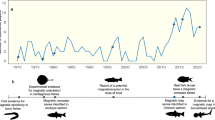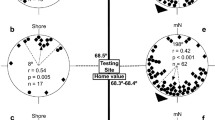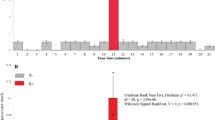Abstract
Although the hypothesis that animals use a magnetic sense to navigate over long distances in the sea is intuitively appealing, evidence that aquatic vertebrates respond to the magnetic field in nature has been difficult to obtain until recent years. Aquatic vertebrates have, however, been prominent in laboratory-based demonstration and analysis of the magnetic sense and its mechanism. The key conclusions of these studies have been that the magnetic sense exhibits fundamental properties found in other specialized sensory systems and that the magnetic senses of aquatic vertebrates and birds exhibit substantial similarities. In particular, the magnetic sense appears to be selective for the magnetic field stimulus; that is, it responds only to the magnetic field stimulus and does not extract magnetic field information from interactions of the magnetic field with the detector components in other specialized sensory systems. The magnetic sense of aquatic vertebrates is also likely to be highly sensitive to small changes in magnetic fields, with its detector cells operating at close to the limit set by background thermal energy. Finally, it seems likely that the magnetic senses of birds and aquatic vertebrates exhibit substantial similarities in their structure and function.
Laboratory experiments have demonstrated behavioral and neural responses to magnetic direction and intensity in species from four classes of aquatic vertebrates. Magnetic impairment experiments also strongly imply that magnetic field detection in both sea turtles and elasmobranchs is based on singledomain particles of magnetite. At the receptor level, an array of new imaging and microscopic techniques has identified magnetoreceptor cells that contain l-μm-long chains of singledomain magnetite crystals within the olfactory lamellae of rainbow trout. These chains of magnetite crystals will respond only to magnetic fields and appear to have been selected for high sensitivity to small changes in magnetic field stimuli. Recent experiments have demonstrated that the magnetic sense of birds is also based on magnetite located in the nasal region and that the same nerve carries magnetic field information to the brain in both fishes and birds. It therefore seems likely that magnetite is the basis of magnetic field detection in a wide range of vertebrate groups. We conclude that, in the aquatic vertebrates, the magnetic sense can now be demonstrated and analyzed in the laboratory using experimental approaches developed for the study of other sensory modalities. Careful selection of experimental subjects will be required, however, to overcome the challenge of applying insights gained in the laboratory to experimental analysis of the use of the magnetic field in the aquatic environment.
Access this chapter
Tax calculation will be finalised at checkout
Purchases are for personal use only
Preview
Unable to display preview. Download preview PDF.
Similar content being viewed by others
References
Beason, R.C., and Semm, P. (1987). Magnetic responses of the trigeminal nerve system of the bobolink (Dolichonyx oryzivorus). Neurosci. Lett. 80:229–234.
Block, S.M. (1992). Biophysical principles of sensory transduction. In: Sensory Transduction (Corey, D.P., and Roper, S.D., eds.), pp. 1–17. Society of General Physiologists 45th Annual Symposium, Rockefeller University Press.
Courtillot, V., Hulot, G., Alexandrescu, M., le Mouel, J.-L., and Kirschvink, J.L. (1997). Sensitivity and evolution of sea-turtle magnetoreception: Observations, modelling and constraints from geomagnetic secular variation. Terra Nova 9:203–207.
Deutschlander, M.E., Phillips, J.B., and Borland, S.C. (1999). The case for light-dependent magnetic orientation in animals. J. Exp. Biol. 202:891–908.
Diebel, C.E., Proksch, R., Green, C.R., Neilson. P., and Walker, M.M. (2000). Magnetite defines a magnetoreceptor. Nature 406:299–302.
Emlen, S.T. (1975). Migration: Orientation and navigation. In: Avian Biology (Farner, D.S., and King, J.R. eds.), Vol. 5, pp. 129–219. New York: Academic Press.
Finger, T.E., St. Jeor, V.L., Kinnamon, J.C., and Silver, W.L. (1990). Ultrastructure of substance P-and CGRP-immunoreactive nerve fibers in the nasal epithelium of rodents. J. Comp. Neurol. 294:293–305.
Fischer, J.H., Freake, M.J., Borland, S.C., and Phillips, J.B. (2001). Evidence for the use of magnetic map information by an amphibian. Anim. Behav. 62:1–10.
Gould, J.L. (1982). The map sense of pigeons. Nature 296:205–211.
Griffin, D.R. (1982). Ecology of migration: Is magnetic orientation a reality? Quart. Rev. Biol. 57:293–295.
Haugh, C.V., and Walker, M.M. (1998). Magnetic discrimination learning in rainbow trout (Oncorhynchus mykiss). J. Navigation 51:35–45.
Haugh, C.V., Wiltschko, R., Wiltschko, W, and Walker, M.M. (2001). P-GPS (Pigeon Geomagnetic Positioning System): II. Consistent effect of attached magnets on initial orientation of homing pigeons (Columba livia). Royal Institute of Navigation Conference on Animal Navigation, Oxford University, April 2001.
Hodson, R.B. (2000). Magnetoreception in the short-tailed stingray, Dasyatis brevicaudata. MSc thesis, University of Auckland, New Zealand.
Holland, K.N., Brill, R.W, and Chang, R.K.C. (1990). Horizontal and vertical movements of yellowfin and bigeye tuna associated with fish aggregating devices. Fish. Bull. U.S. 88:493–507.
Irwin, W.P., and Lohmann, K.J. (2000). Orientation behavior of sea turtle hatchlings: Disruption by magnets. Abstract, Annual Meeting, Society for Integrative and Comparative Biology. Amer. Zoologist 39:5.
Kalmijn, A.J. (1978). Experimental evidence of geomagnetic orientation in elasmobranch fishes. In: Animal Migration, Navigation and Homing (Schmidt-Koenig, K., and Keeton, W.T., eds.), pp. 347–353. New York: Springer-Verlag.
Kalmijn, A.J. (1981). Biophysics of geomagnetic field detection. IEEE Trans. Mag. 17:1113–1124.
Kalmijn, A.J. (1982). Electric and magnetic field detection in elasmobranch fishes. Science 218:916–918.
Keeton, WT (1971). Magnets interfere with pigeon homing. Proc. Nat. Acad. Sci. USA 68:102–106.
Keeton, W.T. (1972). Effects of magnets on pigeon homing. In: Animal Orientation and Navigation (Galler, S.R., Schmidt-Koenig, K., Jacobs, G.J., and Belleville, R.E. eds.) pp. 579–594. Washington DC: U.S. Government Printing Office.
Keeton, W.T., Larkin, T.S., Walcott, C., and Windsor, D.M. (1974). Normal fluctuations in the earth’s field influence pigeon orientation. J. Comp. Physiol. 95:95–103.
Kirschvink, J.L., and Gould, J.L. (1981). Biogenic magnetite as a basis for magnetic field detection in animals. Biosystems 13:181–201.
Kirschvink, J.L., and Walker, M.M. (1985). Particlesize considerations for magnetite-based magnetoreceptors. In: Magnetite Biomineralization and Magnetoreception by Living Organisms: A New Biomagnetism (Kirschvink, J.L., Jones, D.S., and MacFadden, BJ. eds.), pp. 243–254. New York: Plenum.
Kirschvink, J.L., Dizon, A.E., and Westphal, J.A. (1986). Evidence from strandings for geomagnetic sensitivity in cetaceans. J. Exp. Biol. 120:1–24.
Kirschvink, J.L., Walker, M.M., and Diebel, C.E. (2001). Magnetite-based magnetoreception. Current Opinion in Neurobiology 11:462–467.
Kirschvink, J.L., Walker, M.M., Chang, S.-B., Dizon, A.E., and Peterson, K.A. (1985). Chains of singledomain magnetite particles in the chinook salmon, Oncorhynchus tshawytscha. J. Comp. Physiol. A. 157:375–381.
Klimley, A.P (1993). Highly directional swimming by scalloped hammerhead sharks, Sphyrna lewini, and substrate irradiance, temperature, bathymetry and geomagnetic field. Mar. Biol. 117:1–22.
Klinowska, M. (1985). Cetacean live stranding sites relate to geomagnetic topography. Aquatic Mammals 1:27–32.
Kramer, G. (1953). Wird die Sonnenhöhe bei der Heimfindeorientierung verwertet? J. Ornithol. 4:201–219.
Leask, M.J.M. (1977). A physicochemical mechanism for magnetic field detection by migratory birds and homing pigeons. Nature 267:144–145.
Lohmann, K.J., and Lohmann, C.M.F. (1996). Orientation and open-sea navigation in sea turtles. J. Exp. Biol. 199:73–81.
Lohmann, K.J., Cain, S.D., Dodge, S.A., and Lohmann, C.M.F. (2001). Regional magnetic fields as navigational markers for sea turtles. Science 294:364–366.
Mann, S., Sparks, N.H.C., Walker, M.M., and Kirschvink, J.L. (1988). Ultrastructure, morphology and organization of biogenic magnetite from sockeye salmon, Oncorhynchus nerka: Implications for magnetoreception. J. Exp. Biol. 140:35–49.
Mead, J.G. (1979). An analysis of cetacean strandings along the eastern coast of the United States. In: Biology of Marine Mammals: Insights Through Strandings (Geraci, J.B., and St. Aubin, DJ. eds.), pp. 54–68. U.S. Marine Mammal Commission Report MMC-77/13.
Papi, F., Luschi, P., Crosio, E., and Hughes, G.R. (1997). Satellite-tracking experiments on the navigational ability and migratory behaviour of the loggerhead turtle Caretta caretta. Mar. Biol. 129:215–220.
Papi, F., Luschi, P., Åkesson, S., Capogrossi, S., and Hays, G.C. (2000). Open-sea migration of magnetically disturbed sea turtles. J. Exp. Biol. 203:3435–3443.
Phillips, J.B. (1977). Use of earth’s magnetic field by orienting cave salamanders (Eurycea lucifuga). J. Comp. Physiol. A. 121:273–288.
Quinn, T.P (1980). Evidence for celestial and magnetic compass orienation in lake-migrating sockeye salmon fry. J. Comp. Physiol. A. 137: 243–248.
Semm, P., and Beason, R.C. (1990). Responses to small magnetic field variations by the trigeminal system of the bobolink. Brain Res. Bull. 25: 735–740.
Skiles, D.D. (1985). The geomagnetic fields: Its nature, history and biological relevance. In: Magnetite Biomineralization and Magnetoreception by Living Organisms: A New Biomagnetism (Kirschvink, J.L., Jones, D.S., and MacFadden, B.J. eds.), pp. 43–102. New York: Plenum.
Steiner, L., Bürgi, C., Werffel, S., Dell’Omo, G., Valenti, P., Tröster, G., Wolfer, D.P., and Lipp, H.-P. (2000). A GPS logger and software for analysis of homing in pigeons and small mammals. Physiol. Behav. 71:589–596.
Taylor, P.B. (1986). Experimental evidence for geomagnetic orientation in juvenile salmon, Oncorhynchus tshawyscha Walbaum. J. Fish Biol. 28:607–623.
Taylor, P.B. (1987). Experimental evidence for juvenile Chinook salmon, Oncorhynchus tshawytscha Walbaum orientation at night and in sunlight after a 7° change in latitude. J. Fish Biol. 31:89–111.
Viguier, C. (1882). Le sens d’orientation et ses organs chez les animaus et chez l’homme. Rev. Philosophique de la France et de l’Étrangere 14:1–36.
Walcott, C. (1977). Anomalies in the earth’s magnetic field increase the scatter of pigeons’ vanishing bearings. In: Animal Migration, Navigation and Homing (Schmidt-Koenig, K., and Keeton, W.T. eds.), pp. 143–151. New York: Springer-Verlag.
Walcott, C. (1992). Pigeons at magnetic anomalies: The effect of loft location. J. Exp. Biol. 170:127–141.
Walcott, C., and Green, R.P. (1974). Orientation of homing pigeons altered by a change in the direction of an applied magnetic field. Science 184:180–182.
Walker, M.M. (1984). Learned magnetic field discrimination in the yellowfin tuna, Thunnus albacares. J. Comp. Physiol. A. 155:673–679.
Walker, M.M., and Bitterman, M.E. (1988). Attached magnets disrupt magnetic field discrimination by honeybees. J. Exp. Biol. 141:447–451.
Walker, M.M., and Bitterman, M.E. (1989). Honeybees can be trained to respond to very small changes in geomagnetic field intensity. J. Exp. Biol. 145:489–494.
Walker, M.M., Kirschvink, J.L., Ahmed, G., and Dizon, A.E. (1992). Fin whales (Balaenoptera physolus) avoid geomagnetic gradients during migration. J. Exp. Biol. 171:67–78.
Walker, M.M., Kirschvink, J.L., Chang, S.-B.R., and Dizon, A.E. (1984). A candidate magnetic sense organ in the yellowfin tuna, Thunnus albacares. Science 224:751–753.
Walker, M.M., Diebel, C.E., Haugh, C.V., Pankhurst, P.M., Montgomery, J.C., and Green, C.R. (1997). Structure and function of the vertebrate magnetic sense. Nature 390:371–376.
Wiltschko, W (1972). The influence of magnetic total intensity and inclination on directions chosen by migrating European robins. In: Animal Orientation and Navigation (Galler, S.R., Schmidt-Koenig, K., Jacobs, G.J., and Belleville, R.E. eds.), pp. 569–578. Washington DC: US Government Printing Office.
Yano, A., Ogura, M., Sato, A., Sakaki, Y., Shimizu, Y., Baba, N., and Nagasawa, K. (1997). Effect of modified magnetic field on the ocean migration of maturing chum salmon. Mar. Biol. 129:523–530.
Author information
Authors and Affiliations
Editor information
Editors and Affiliations
Rights and permissions
Copyright information
© 2003 Springer-Verlag New York, Inc.
About this chapter
Cite this chapter
Walker, M.M., Diebel, C.E., Kirschvink, J.L. (2003). Detection and Use of the Earth’s Magnetic Field by Aquatic Vertebrates. In: Collin, S.P., Marshall, N.J. (eds) Sensory Processing in Aquatic Environments. Springer, New York, NY. https://doi.org/10.1007/978-0-387-22628-6_3
Download citation
DOI: https://doi.org/10.1007/978-0-387-22628-6_3
Publisher Name: Springer, New York, NY
Print ISBN: 978-0-387-95527-8
Online ISBN: 978-0-387-22628-6
eBook Packages: Springer Book Archive




